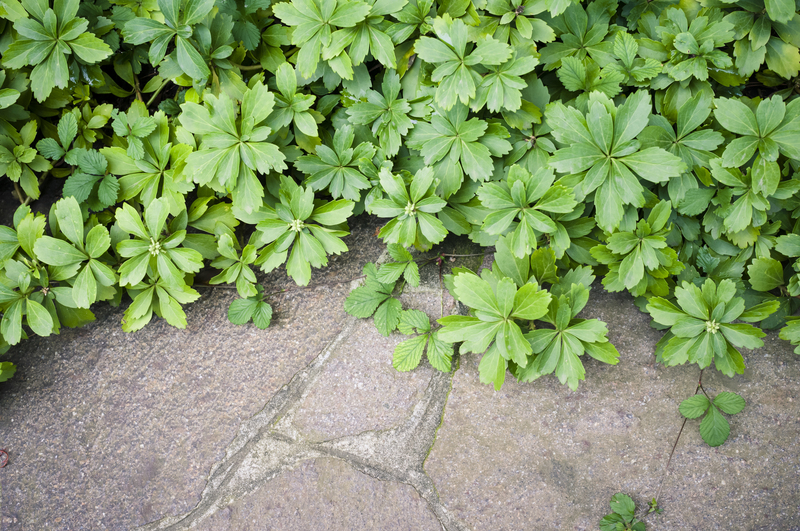Insider Tips for Orchid Enthusiasts
Posted on 18/05/2025
Insider Tips for Orchid Enthusiasts
Orchids have captured the fascination of plant lovers worldwide for centuries, renowned for their exotic beauty, remarkable diversity, and mystique. Whether you're just beginning your orchid journey or are already a seasoned grower, tapping into expert insights can profoundly enhance your growing experience. In this comprehensive guide, discover essential and advanced insider tips for orchid enthusiasts--from selecting species to encouraging vibrant blooms, troubleshooting common issues, and building an impressive collection.

Why Orchids Captivate
Orchids (family Orchidaceae) boast more than 25,000 species and 100,000 hybrids worldwide, making them one of the most diverse plant families. Their stunning, intricate flowers, fascinating pollination strategies, and wide adaptability make them irresistibly alluring to plant lovers and collectors.
- Unique blooms - Every orchid species showcases an unparalleled shape, color, and fragrance.
- Diversity of species - From miniature gems to lush epiphytes and terrestrials, there's an orchid for every grower.
- Symbolism - Orchids represent luxury, refinement, and beauty, holding cultural significance across the globe.
- Collector's passion - The challenge of cultivation and rarity fuels a thriving community of orchid enthusiasts.
Selecting the Right Orchid: Foundation for Success
The journey to orchid mastery begins with choosing the right plants for your skill level, environment, and interest. Orchid hobbyists should consider:
- Skill level: Beginners will fare better with resilient varieties like Phalaenopsis (moth orchids), Cymbidium, and Dendrobium.
- Growing environment: Assess your light, temperature, and humidity to select orchids suited to your conditions. For example, Vandas love intense light, while Paphiopedilum prefer shade.
- Personal preference: Flower color, fragrance, plant size, and blooming frequency all cater to different collector goals.
- Source: Purchase orchids from reputable nurseries and avoid wild-collected plants to support conservation efforts.
Orchid Care Essentials: Pro Tips from Experienced Growers
1. Mastering Light Requirements
Lighting is the top factor influencing orchid health and flowering. Here are insider tips tailored to orchid lovers:
- Assess natural light: Observe your home's exposure. East or south-facing windows provide ideal light for most orchids.
- Artificial grow lights: For spaces lacking sunlight, full-spectrum LED or fluorescent grow lights can replicate natural conditions.
- Light indicators: Healthy leaves show vibrant, medium-green colors; dark green means too little, while reddish hues indicate too much.
2. Watering Wisdom: How Much and When?
Overwatering remains the leading cause of orchid decline, especially among beginners. Consider these watering strategies for thriving orchid collections:
- Check the media: Only water when the potting mix feels dry an inch below the surface.
- Morning routine: Water in the morning to ensure foliage dries by night, reducing disease risk.
- Use pure water: Rainwater or distilled water often works best, especially for sensitive species.
- Soaking method: Many enthusiasts prefer soaking pots for 10-15 minutes, then draining thoroughly.
3. Orchid Humidity Hacks
Most orchids love humidity levels between 50-80%. Here are insider humidity tips for orchid hobbyists:
- Group plants together to create a humid microclimate.
- Use humidity trays (shallow trays filled with pebbles and water beneath pots).
- Mist foliage with distilled water, especially during dry seasons.
- Consider a room humidifier for large orchid collections.
4. Potting Media Insights
Orchids don't grow well in typical potting soil! Select a media depending on your type:
- Bark-based mixes: Ideal for most epiphytic species like Cattleya and Dendrobium.
- Sphagnum moss: Retains more moisture, best for seedlings and moisture-loving orchids.
- Specialty blends: Charcoal, perlite, and coconut husk can all be used for drainage and aeration.
5. Fertilizer Fundamentals
Proper feeding helps maintain vibrant growth and prolific blooming. Remember the orchid feeding mantra: "Weakly, weekly."
- Dilute fertilizers: Use orchid or balanced houseplant fertilizer at one-quarter strength.
- Feed during growth: Active growing seasons (spring and summer) require more feeding. Reduce or stop during dormancy.
- Flush monthly: Once a month, water generously to flush out fertilizer salts and residues.
Advanced Orchid Enthusiasts' Techniques
Repotting Like a Pro
Repotting every 1-2 years keeps roots healthy. Here's how experienced orchid growers tackle it:
- Choose the right time: Repot immediately after flowering or when you see fresh root growth.
- Trim wisely: Sterilize scissors and remove all dead roots before replanting.
- Never overpot: Orchids thrive in slightly snug containers that allow good drainage and air circulation.
- Refresh media: Always replace old media to prevent rot and maintain aeration.
Encouraging Reblooming: The Hidden Art
- Temperature triggers: Many varieties, such as Phalaenopsis, initiate blooms if night temperatures drop ~10?F below day temperatures for a few weeks.
- Rest periods: Some species need a seasonal temperature/watering reduction to flower; research your orchid's needs.
- Pruning spikes: After flowering, trim spent spikes back to a node to sometimes encourage side spikes in Phalaenopsis.
Fighting Pests and Diseases Effectively
- Routine inspection: Regularly check under leaves, roots, and buds for pests like mealybugs, scale, or spider mites.
- Nontoxic remedies: Begin with a gentle soap and water spray, neem oil, or rubbing alcohol on a cotton swab.
- Isolation: Quarantine new or sick orchids to avoid infestations spreading through your collection.
Propagation Secrets
- Division: For sympodial orchids, divide the plant ensuring each portion has at least 3-4 pseudobulbs or growths.
- Keiki production: Some species produce "babies" (keikis) on flower spikes or stems. Detach and pot once roots grow to 2-3 inches.
- Seed propagation: Advanced enthusiasts explore flasking orchid seeds, though it requires sterile conditions and patience.
Insider Collection-Building Tips for Orchid Lovers
Deepening Your Orchid Collection
As your passion grows, so does your desire to deepen your knowledge and collection. Consider these expert suggestions:
- Specialize: Focus on a genus (like Paphiopedilum, Oncidium, or miniatures) for a cohesive collection and easier care.
- Join the community: Become a member of local orchid societies, join online forums, and participate in shows for networking and inspiration.
- Expand slowly: Add new orchids as your expertise grows--and only as your space and care routine allow.
- Document your plants: Keep a journal or spreadsheet, tracking species, bloom dates, care notes, and photographs for reference.
Sourcing Rare and Unusual Orchids
- Buy from reputable vendors: Choose respected orchid nurseries and avoid wild-collected plants to support sustainability.
- Attend shows and sales: Orchid shows boast rare species and hybrids not found in stores--perfect for collectors.
- Swap with other growers: Trading divisions or keikis with fellow orchid enthusiasts expands your collection affordably.
Common Mistakes and How to Avoid Them
All orchid lovers make mistakes, particularly when learning. These common pitfalls can be prevented with a little insider knowledge:
- Overwatering: The most common issue; always let media dry out between waterings.
- Insufficient light: Without enough light, orchids rarely bloom--move plants closer to a window or invest in grow lights.
- Ignoring root health: Orchids with rotting roots can't thrive; repot promptly at any sign of decay.
- Overpotting: Avoid large pots, which retain excess moisture and suffocate roots.
- Neglecting feeding: A weak, regular feeding schedule ensures lush growth and flowers.
Expert Resources for Orchid Enthusiasts
Leverage these resources to delve deeper into the world of orchids:
- American Orchid Society (AOS.org): The definitive resource for learning, judging, and networking in North America.
- Orchid societies: Local and national groups offer meetings, shows, guest speakers, and plant sales.
- Books and publications: A few essentials include Ortho's All About Orchids, The Orchid Whisperer by Bruce Rogers, and journals like Orchids or The Orchid Digest.
- Online communities: Join forums such as OrchidBoard, Reddit's Orchid sub, and Facebook groups for real-time advice.
- Workshops and classes: Many botanical gardens and societies run hands-on orchid care clinics and shows.

Frequently Asked Questions About Orchid Growing
- Why won't my orchid rebloom? Light insufficiency and lack of temperature variation are common causes. Ensure your orchid receives enough filtered light and a drop in night temperatures to trigger new flower spikes.
- How often do I repot orchids? Generally, repot every 1-2 years or when fresh root growth emerges, using new potting mix to avoid breakdown and disease.
- What is the white fuzz or sticky residue on my orchid? This may indicate a pest infestation (mealybugs, scale, or aphids). Isolate the plant and treat with gentle remedies as described above.
- Can I grow orchids outdoors? Most orchids prefer protected indoor or greenhouse environments, though some, like hardy Cymbidiums, can be grown outdoors in mild climates with filtered light.
Conclusion: Cultivate Orchid Success!
Becoming a successful orchid grower is as much an art as a science. Use these insider tips for orchid enthusiasts to unlock the secrets of vibrant blooms, healthy roots, and a treasured collection. With patience, keen observation, and the willingness to keep learning, you'll become an orchid maestro capable of turning any home into an exotic paradise. Happy growing!



